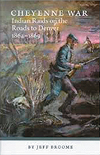
Cheyenne War: Indian Raids on the Roads to Denver 1864–1869, by Jeff Broome, Aberdeen Books, Sheridan, Colo., 2013, $52.95
To know only of the soldiers’ killing and mutilation of Indian women and children at Sand Creek is to know only part of the sad story of the five years of raiding, fighting, scalping and killing author Jeff Broome calls the Cheyenne War. He mostly covers ground in Kansas, Nebraska and Colorado territories—more specifically on the Denver Road along the South Platte, the Smoky Hill Trail, and the Santa Fe Trail, which actually passed south of Denver on the way to Santa Fe, New Mexico Territory—from the spring of 1864 until the significant if little known Battle of Summit Springs (Colo.) on July 11, 1869. The Northern and Southern Cheyennes were usually not acting alone in the raiding; other Plains Indians such as the Arapahos, Kiowas and Lakotas played a role. Broome acknowledges that “a small number of soldiers committed unspeakable atrocities to several of the innocent women and children caught at Sand Creek” on November 29, 1864. But he also points out that only six of 1,450 Western fights between whites and Indians from 1850 to 1890 had more white casualties than happened at what is often called the Sand Creek Massacre. Broome only touches on the actual soldier-Indian battles of the period, for it is neither the military nor Indian perspectives that interest him most—rather he concentrates on what he calls “the civilian perspective.”
The focus of Broome’s research was the National Archives’ extensive and largely neglected files (more than 13,000, he says) that contain depredation claims by settlers and freighters. He found several hundred files with affidavits detailing the specifics of Indian raids during the Cheyenne War (called other things by other historians and not usually considered one five-year war). In his introduction Broome explains the nature and requirements of these claims, pointing out that the monetary value of claims were frequently reduced (some were outright fraudulent), but that the facts of the attacks were not challenged. “One quirk in the law was that there was no compensation for injury or death,” writes Broome. The author, however, details all the injury and death associated with the destroyed property (homesteads and wagons) and stolen livestock. The raiders were rarely shy about killing men, women and children, mutilating the dead and abusing captives (mostly women and children).
Many emigrant wagons and freighter wagons did get through to Denver or beyond without casualties, but after reading about one Indian depredation after another here, one might wonder how that was even possible or else attribute the successful trips to good fortune or dumb luck. Deeper analysis of this would have been nice. Treaties never really ended the attacks. The Fort Laramie Treaty of 1866 lessened the problems along the Denver trails for a while, but it led to greater warring activities to the north along the Bozeman Trail. Broome seems to have sympathy for most of the citizens who lost property if not their lives. His chapter covering the Spillman Creek Raid of May 30, 1869, is called “Bury My Heart at Spillman Creek.” The Indians show little mercy on these pages, although the Sioux Spotted Tail comes to see the light (and no longer wants to kill whites). Even the motives of Cheyenne Chief Black Kettle, often seen as the ultimate good Indian and victim (at Sand Creek and the Battle of the Washita) are challenged. “To freighters who knew him and who survived attack by raiding Indians, the feeling was that Black Kettle acted as a spy for the militant warriors,” writes Broome. Any reader—even those who disagree with Broome’s approach or observations—will admire the labor and time that went into producing this follow-up to his fine 2009 book Dog Soldier Justice: The Ordeal of Susanna Alderdice in the Kansas Indian War. The detailed depredations might be hard for some readers to stomach, but the payoff is ample drama, displays of citizen courage and a wealth of new information. Look for five helpful maps by Joan Pennington, longtime mapmaker for Wild West.
Editor




